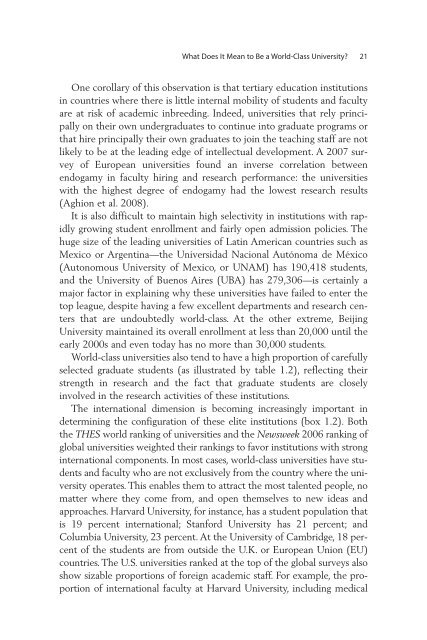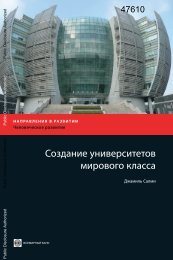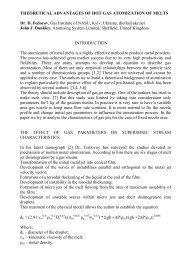The Challenge of Establishing World-Class Universities
The Challenge of Establishing World-Class Universities - ISBN ...
The Challenge of Establishing World-Class Universities - ISBN ...
- No tags were found...
Create successful ePaper yourself
Turn your PDF publications into a flip-book with our unique Google optimized e-Paper software.
What Does It Mean to Be a <strong>World</strong>-<strong>Class</strong> University? 21<br />
One corollary <strong>of</strong> this observation is that tertiary education institutions<br />
in countries where there is little internal mobility <strong>of</strong> students and faculty<br />
are at risk <strong>of</strong> academic inbreeding. Indeed, universities that rely principally<br />
on their own undergraduates to continue into graduate programs or<br />
that hire principally their own graduates to join the teaching staff are not<br />
likely to be at the leading edge <strong>of</strong> intellectual development. A 2007 survey<br />
<strong>of</strong> European universities found an inverse correlation between<br />
endogamy in faculty hiring and research performance: the universities<br />
with the highest degree <strong>of</strong> endogamy had the lowest research results<br />
(Aghion et al. 2008).<br />
It is also difficult to maintain high selectivity in institutions with rapidly<br />
growing student enrollment and fairly open admission policies. <strong>The</strong><br />
huge size <strong>of</strong> the leading universities <strong>of</strong> Latin American countries such as<br />
Mexico or Argentina—the Universidad Nacional Autónoma de México<br />
(Autonomous University <strong>of</strong> Mexico, or UNAM) has 190,418 students,<br />
and the University <strong>of</strong> Buenos Aires (UBA) has 279,306—is certainly a<br />
major factor in explaining why these universities have failed to enter the<br />
top league, despite having a few excellent departments and research centers<br />
that are undoubtedly world-class. At the other extreme, Beijing<br />
University maintained its overall enrollment at less than 20,000 until the<br />
early 2000s and even today has no more than 30,000 students.<br />
<strong>World</strong>-class universities also tend to have a high proportion <strong>of</strong> carefully<br />
selected graduate students (as illustrated by table 1.2), reflecting their<br />
strength in research and the fact that graduate students are closely<br />
involved in the research activities <strong>of</strong> these institutions.<br />
<strong>The</strong> international dimension is becoming increasingly important in<br />
determining the configuration <strong>of</strong> these elite institutions (box 1.2). Both<br />
the THES world ranking <strong>of</strong> universities and the Newsweek 2006 ranking <strong>of</strong><br />
global universities weighted their rankings to favor institutions with strong<br />
international components. In most cases, world-class universities have students<br />
and faculty who are not exclusively from the country where the university<br />
operates. This enables them to attract the most talented people, no<br />
matter where they come from, and open themselves to new ideas and<br />
approaches. Harvard University, for instance, has a student population that<br />
is 19 percent international; Stanford University has 21 percent; and<br />
Columbia University, 23 percent. At the University <strong>of</strong> Cambridge, 18 percent<br />
<strong>of</strong> the students are from outside the U.K. or European Union (EU)<br />
countries. <strong>The</strong> U.S. universities ranked at the top <strong>of</strong> the global surveys also<br />
show sizable proportions <strong>of</strong> foreign academic staff. For example, the proportion<br />
<strong>of</strong> international faculty at Harvard University, including medical







